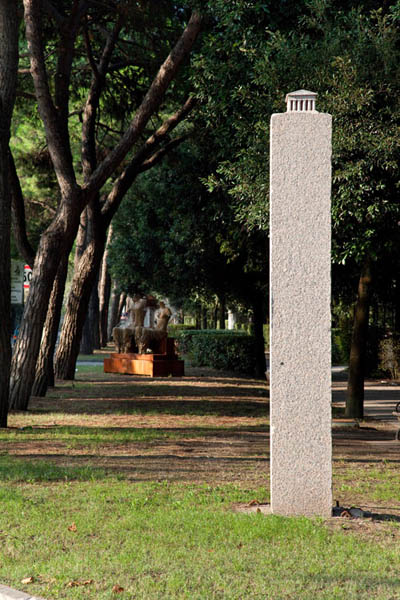Italy - Girolamo Ciulla
"Whatever is produced in Sicily, from farm produce to the fruits of human creative capacity, is very close to what we could call perfect”. This is what a Roman grammarian of the imperial age wrote, thus confirming the wonder the island aroused in visitors because of the excellent weather, the beauty of the landscape and the grandeur of its monuments. About this land blessed by the Gods, Homer, basing his remarks on the tales told by the first sailors who had ventured west, wrote, "All these things spring for them in plenty, unsown and untilled, wheat, and barley, and vines, which bear great clusters of the juice of the grape, and the rain of Zeus gives them increase”. (Odyssey, book IX, verses 109-111). Girolamo Ciulla, a sculptor, was born in Sicily, and his work deeply echoes his love for the places and his passion for an architecture which sinks its roots in the age of the ancient Greek settlements in Southern Italy. One of the most repeated motives in Ciulla’s works of art is the temple in Agrigento. The colony founded by the inhabitants of Gela approx. in 580 B.C. a few kilometres from the sea was set on two rises which bordered two watercourses, the Akràgas stream, after which the town of Agrigento is named, and the Hypsas. The long walls which surrounded the town began at the hills, one of which was called Atenea rock, and extended down to the valley where the temples stood. The exceptional nature of the complex already amazed the ancients, who invented stories about the town of Agrigento which told of a rare opulence. A wealth which actually came from the olives and wine trade with the town of Carthage. And the nine temples, eight of which were built in few years between 480 and 406 B.C., just tell how prosperous Agrigento was. The temple is one of the most striking ideas of sacred architecture. Starting from its components, the horizontal base, the walls, the columns, the trabeation, the roof and the pediment, this building becomes part of a landscape as if it were a huge sculpture. Unlike other places of worship, here the inner room had a secondary role. In ancient times the temple was a place which was nearly forbidden to common people. Since it was the divinity’s home, the congregation stayed outside and the community gathered for the sacrifice around the altar outside the sacred enclosure. The largest shrines usually rose in an area outside the town. They were often surrounded by forests and, if possible, they were built so as to face the Mediterranean Sea. Using the finest stones, Ciulla reproduces in scale the Tempio della Concordia, one of the most successful examples of the Doric order. The original has six columns on the front side and twelve columns on the long sides, and the revisiting by the Sicilian artist restores the whole sense of magic sacredness. Ciulla respects each element: the architrave laid on the peristyle, the fascia with the friezes, the four steps at the entrance. The result is a miniature temple which preserves its majesty. The monumental work of art Ciulla takes to OPEN 12 consists of a colossal stele which reaches towards the sky. On its square top stands the Temple of Concordia. Placed so high, this miniature place of worship comes to the attention of the audience in a way which is not in the least trite for different reasons. Looking up reveals man’s ancestral theoretic inclination to search for a meaning. In addition, Ciulla’s temple, placed in this way, faces the sea, the same Mediterranean Sea also faced by the original some thousand kilometres to the south. Placed just at the entrance of OPEN 12 the Stele con tempio therefore offers visitors the blessing of the ancient gods.
Text by Anna Caterina Bellati
